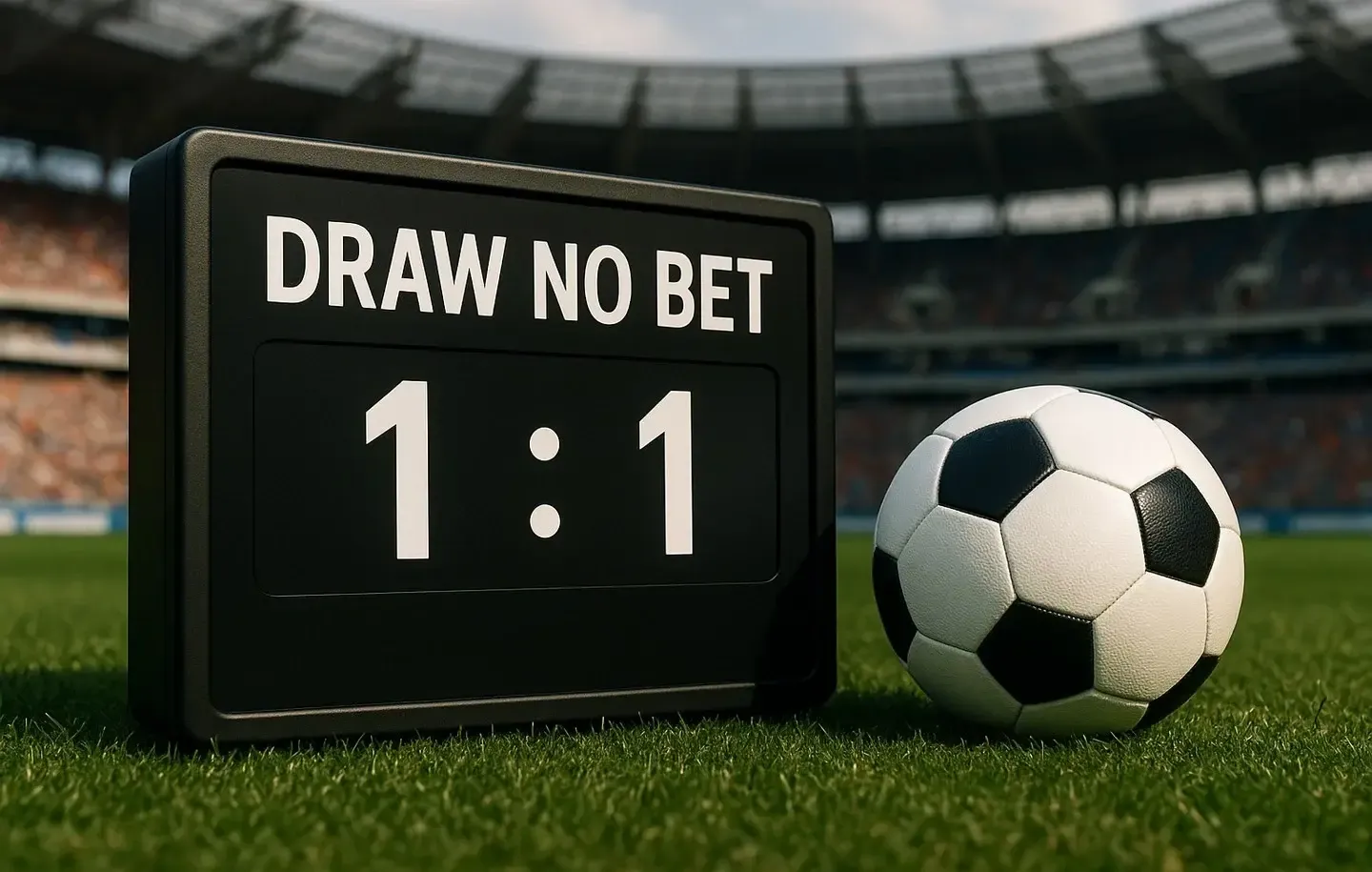Draw No Bet Meaning Explained. What Is Draw No Bet?

Draw No Bet has become the safety net of sports betting - a middle ground between playing it safe and going for glory. This betting market eliminates the most frustrating outcome in football: the draw that kills your bet.
Understanding Draw No Bet Betting: Meaning & Strategy

The draw no bet meaning is straightforward. DNB strips away one of three possible outcomes in a match. Instead of betting on home win, draw, or away win, DNB offers just two options: back a team to win, and if the match ends in a draw, get your stake back.
Here's what makes DNB attractive:
• Risk reduction - Draws can't hurt your bankroll
• Better odds than Double Chance - Higher returns than covering two outcomes
• Simple stake returns - No complicated calculations on draws
• Perfect for tight matches - Ideal when teams are evenly matched
• Accumulator insurance - Protects parlays from draw results
Strategic uses for Draw No Bet:
• Back an outsider, with the security of the draw - Support underdogs without fearing stalemates
• Protect your stake if you believe there is a reasonable chance of a draw - Insurance for uncertain matches
• Trade a big favourite in-play when they are losing - Exit strategy for live betting positions
The draw no bet strategy behind DNB revolves around identifying matches where a draw seems likely but backing the slight favorite offers value. Derby matches, cup finals, and games between mid-table teams often present perfect DNB opportunities.
Draw No Bet Explained. How It Works in Sports Betting
Many bettors ask "what is draw no bet?" Think of it as insurance for your football bets. When placing a DNB wager, three scenarios exist:
- Your team wins = You win the bet
- The match draws = Stake returned
- Your team loses = You lose the bet
The beauty lies in its simplicity. No half stakes, no partial returns - just straightforward outcomes that make bankroll management easier. Understanding how does draw no bet work becomes second nature once you place a few bets.
Placing a Draw No Bet: Step-by-Step Guide
Getting started with DNB betting follows a simple process. First, identify a match where DNB markets are offered (most bookmakers provide this for major leagues). For those wondering "whats draw no bet mean" in practice, the table below shows exactly how results differ from regular betting.
Here's how typical results play out:
Match Result | Regular Bet Outcome | Draw No Bet Outcome | Difference |
| Team A Wins 2-1 | Win at 2.50 odds | Win at 1.75 odds | Lower profit, same result |
| Match Draws 1-1 | Lose entire stake | Stake returned | DNB saves your money |
| Team A Loses 0-1 | Lose entire stake | Lose entire stake | No difference |
Creating Custom Draw No Bet Odds from 1X2 Markets
Sometimes bookmakers don't offer DNB markets, but savvy bettors can create their own using standard 1X2 odds. This involves splitting stakes between the win and draw markets to replicate DNB conditions. Essentially, draw no bet means creating a position where draws become neutral outcomes.
Example stake distribution for £100 DNB equivalent:
• Team A to Win: £73.50 at 2.40 odds
• Draw: £26.50 at 3.30 odds
• Effective DNB odds: 1.76
• Total stake: £100 (returns £100 on draw)
The key is calculating stakes. So that a draw returns your total deposit. While maintaining proportional profits on a win. For newcomers asking "what is a draw no bet", this method demonstrates the underlying mechanics.
How to Convert 1X2 Odds into Draw No Bet Odds
Converting standard odds to DNB requires understanding the relationship between all three markets. The formula considers the draw probability's impact on win odds.
Draw odds example conversion:
- Manchester United: 2.20 to win
- Draw: 3.40
- Arsenal: 3.60 to win
Manchester United DNB odds. They = approximately 1.58 Arsenal DNB odds, and they, in turn, approximately 2.59.
The calculation removes draw probability from the equation, redistributing it between the two win outcomes.
Stakes & Profit Calculation for Draw No Bet Wagers
Understanding potential returns helps manage betting banks effectively. DNB calculations differ from standard bets due to the stake return mechanism.
Calculation example:
- Stake. £50 on Liverpool DNB at 1.65
- Liverpool wins. Return = £50 × 1.65 = £82.50 (Profit: £32.50)
- Match draws. Return = £50 (Profit: £0)
- Liverpool loses. Return = £0 (Loss: £50)
This transparency makes DNB perfect for systematic betting approaches.
How to Calculate Profit in Draw No Bet Betting
Profit calculations in DNB markets require factoring in the reduced odds compared to standard win markets. Here's a comprehensive breakdown:
Stake | DNB Odds | Win Return | Draw Return | Loss Return | Net Profit (Win) |
| £20 | 1.50 | £30 | £20 | £0 | £10 |
| £50 | 1.80 | £90 | £50 | £0 | £40 |
| £100 | 2.20 | £220 | £100 | £0 | £120 |
The trade-off becomes clear: lower potential profits in exchange for draw protection.
Asian Handicap vs. Draw No Bet: Key Betting Differences
`
Both markets offer draw protection. But Asian Handicap (AH) and DNB serve different purposes. DNB simply eliminates draws, while AH adjusts the match outcome with goal advantages or disadvantages.
DNB suits matches between evenly-matched teams where picking a winner feels risky. Asian Handicap 0 produces identical results to DNB, but other AH lines create entirely different betting propositions. AH ±0.5 eliminates draws by forcing a result, while AH ±0.25 splits stakes between two different lines.
The choice depends on match analysis. DNB works when backing slight favorites in competitive matches. Asian Handicaps excel when clear quality differences exist but odds lack value.
Using Draw No Bet to Improve Your Betting Strategy
Incorporating DNB into betting strategies opens new possibilities. Long-term bettors appreciate the variance reduction - fewer losing bets mean steadier bankroll growth, even with lower individual profits. The bet no draw approach particularly suits conservative bankroll management.
DNB shines in accumulator bets. Adding one or two DNB selections to parlays provides insurance against common accumulator killers: unexpected draws in "banker" matches. The slightly reduced odds often prove worthwhile when entire accumulators survive thanks to stake returns.
Consider DNB for matches featuring:
- Local derbies with heightened tension
- End-of-season games with uncertain motivation
- Cup matches heading toward extra time
- Teams known for defensive tactics
Smart money management with DNB involves accepting lower returns for increased bet frequency. Rather than risking large stakes on standard markets, spreading smaller DNB bets across multiple matches often yields better long-term results.
The psychological benefit shouldn't be overlooked either. Stake returns on draws prevent the frustration of narrow misses, keeping betting enjoyable rather than stressful. For casual bettors and professionals alike, Draw No Bet represents a valuable tool in the betting arsenal - not a complete strategy, but a tactical option for the right circumstances.
FAQ
Draw No Bet (DNB) is a betting market where your stake is refunded if the match ends in a draw. You only win if your chosen team wins, and you lose only if your team loses.

Sergey Ilyin
An experienced specialist in the field of betting and gambling. He analyzes market trends, player behavior, and the dynamics of online gaming platform development. An expert in the intricacies of sports betting and knowledgeable about the regulatory framework of the gambling industry.
